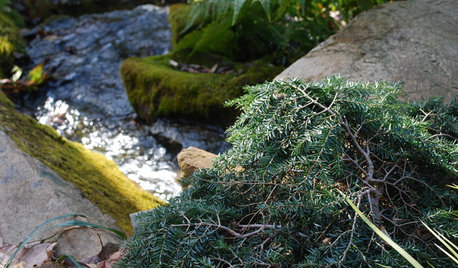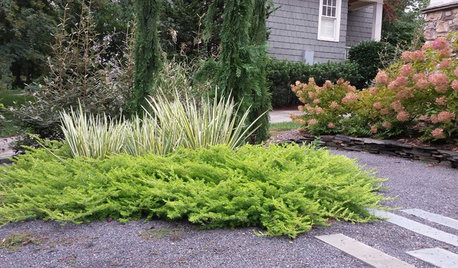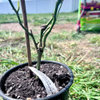Dr. Huey: The most commonly used rose rootstock is the Climber Dr. Huey. Tom Carruth at Weeks Roses says that, except for the Miniatures and Shrubs that are grown on their own roots, "we use Dr. Huey exclusively. It propagates easily, it has a long budding season, the plants harden off and ship well, they store well when bare-rooted, and the general adaptability to the broad area of climates and soils that we ship to is pretty good." Also, it does well in the growing fields of Wasco, California, which produce about 80% of this country's roses (other than Minis). Unfortunately for the rosarian maintaining rootstock in the garden, Dr. Huey tends to mildew (a trait that is not passed on to the budded rose).
De La Grifferaie: For standards, or tree roses, some nurseries still use a separate inner stock, such as De La Grifferaie, for the stem between Dr. Huey rootstock and the grafted rose. However, most nurseries now use a full-length cutting of Dr. Huey: for a 36" tree, a 38" cutting is stuck in the ground, staked, and covered by a long, plastic sleeve (for protection while rooting), then de-thorned and de-eyed by hand, and grafted twice (on opposite sides of the cane) with the desired cultivar.
Multiflora: Multiflora is not used much in California as it is inclined to pick up salts and is not "happy" in alkaline soil. Phil Edmunds of Edmunds Roses says he uses Burr's Multiflora in Oregon because it is a good, all-around fast performer for their shorter growing season; it's winter-hardier than Dr. Huey, it grows faster, and roots quickly in Oregon's colder climate.
Hortico in Canada uses Rosa Multiflora seedlings for most of their stock, one seedling per grafted rose, in order to minimize the incidence of mosaic virus (a disease that is transmitted from the rootstock to the rosebush, or vice versa). Chances are only 1 in 10,000 of getting an infected seedling.
Ekuan states that Multiflora is very sensitive to virus; when an infected bud-eye is grafted onto it, even the mildest case of virus will show substantial infection. He uses it to test questionable budwood.
Fortuniana is an understock used mainly in Florida, or for sales intended for the "Sunshine State." According to Keith Zary of Bear Creek Gardens, "Fortuniana is a very vigorous rootstock, but extremely cold sensitive and doesn't respond very well to freezing weather; it dies quickly." However, it is "tolerant" to nematodes (familiar pests in Florida gardens), which are parasites that invade plant roots - they will infect Fortuniana but they don't seem to like it much, and so, do little damage to the rose plant.
Eddie Edwards, a prominent rosarian from Louisiana, is currently working with Fortuniana in the New Orleans area with some success. He has grafted the Hybrid Teas, Agnes Winchel and Flaming Beauty (not known for their size or bloom production) onto it and produced bushes that are 4 to 5 feet tall, with up to 50 blooms apiece!
[NOTE: Since the time this article was written (1994), roses on Fortuniana rootstock have become more widely available. Fortuniana seems to be very popular in the southern states, especially with sandy soil. Rose exhibitors in SoCal are have been growing roses budded onto Fortuniana since 2000 with great success. The bushes grow taller and wider with many more blooms.]
Manetti, a light pink Noisette, is the preferred rootstock of some rose growers. Wayside Gardens, whose roses are grown in California, uses Manetti on everything (English Roses, Old Garden Roses, Hybrid Teas, etc.) except Minis and the Meidiland Shrub Roses, which are extremely vigorous on their own roots. And Edmunds Roses uses Manetti on those plants that are grown in California, partly because their contract grower buys rootstock that is virus-free ("indexed") from the University of California at Davis and Oregon State University at Corvallis; the grower doesn't have enough indexed Dr. Huey for Edmunds' contract. Also, Edmunds says, "Manetti has more flexible roots that don't break quite as easily as Dr. Huey; I prefer that."
Odorata was a favorite of hybridizer Joe Winchel until his source-plants succumbed to Downy Mildew. Odorata works well for "bench grafts", where the graft is done at the same time as rooting the cutting of the rootstock. Justin Ekuan claims it is a vigorous rootstock but "it suckers like crazy - the champion!" And it is susceptible to crown gall.
Ekuan's current favorite is a Hybrid Multiflora, De La Grifferaie, which he acquired as a sucker from a tree rose. He claims that it does not sucker if the bud-eyes are properly removed. It has big, thick canes that bud easily (the skin separates from the wood "like butter"), few thorns, and it roots fairly well; "You could root a 7-foot cane!"
Other: The rootstock that Joe Winchel currently uses is known as "069", a winter-hardy variety developed by Griffith Buck. The plants are disease-resistant, thornless, and grow quite tall. Winchel says, "I would like it even better if the whips (canes) got bigger in diameter - its maximum size is pencil thick."
Many nurseries experiment with new rose rootstocks. Keith Zary says, "We have lots of experimental rootstocks - we breed them." John Mellon at Coiner Rose Nursery revealed that they are working with a new understock for tree roses, testing it in production. If it performs as well as expected, it will be on the market in the 1995-96 season.
Justin Ekuan discovered a vigorous root system on the miniature rose Pacesetter when trying to remove the plant. When used as an understock for the Hybrid Tea Lynn Anderson, the grafted plants did as well as those on Dr. Huey. He also tried the floribunda rose Iceberg (which had survived a flood in his garden), but found it to be inferior as a rootstock.
Whatever rootstock is used, once the plant has been budded and is growing on the understock, it takes its inherent qualities from the grafted cultivar. No rootstock can improve disease resistance or intrinsic vigor; if a cultivar is inferior, it will not do well on any rootstock.
Although, some rose cultivars do better than others on certain rootstock varieties (e.g., Odorata is said to work better with yellows and yellow-blends than red-family roses), generally, rootstock is chosen for its performance (before it is grafted) in the region where it is grown and propagated. Even with so many choices, Carruth says, "You'll find there's no perfect rootstock, just as there's no perfect rose."


















seil zone 6b MI
roseseek
Related Professionals
Ashburn Landscape Architects & Landscape Designers · Mountain Brook Landscape Architects & Landscape Designers · Taylorsville Landscape Architects & Landscape Designers · Wake Forest Landscape Contractors · Peabody Landscape Contractors · Beachwood Landscape Contractors · Crystal Landscape Contractors · Edinburg Landscape Contractors · Edwardsville Landscape Contractors · Fort Worth Landscape Contractors · Gaithersburg Landscape Contractors · Muttontown Landscape Contractors · Wanaque Landscape Contractors · Yuba City Landscape Contractors · Raytown Landscape Contractorshoovb zone 9 sunset 23
sandandsun
nastarana
User
nastarana
leezen4uOriginal Author
rosefolly
sandandsun
rosesinny
User
Tessiess, SoCal Inland, 9b, 1272' elev
leezen4uOriginal Author
elks
jacqueline9CA